In today’s world, digitalization and process integration are key to business success. ERP (Enterprise Resource Planning) solutions enable centralizing information, automating processes, and enhancing strategic decision-making in real time. ERP is the central axis of digitalization and process optimization in organizations, integrating finance, human resources, supply chain, sales, procurement, and more modules within a single platform shared through a common database. Moreover, this type of solution is rapidly evolving toward cloud environments, incorporating artificial intelligence and machine learning to anticipate anomalies and optimize workflows.
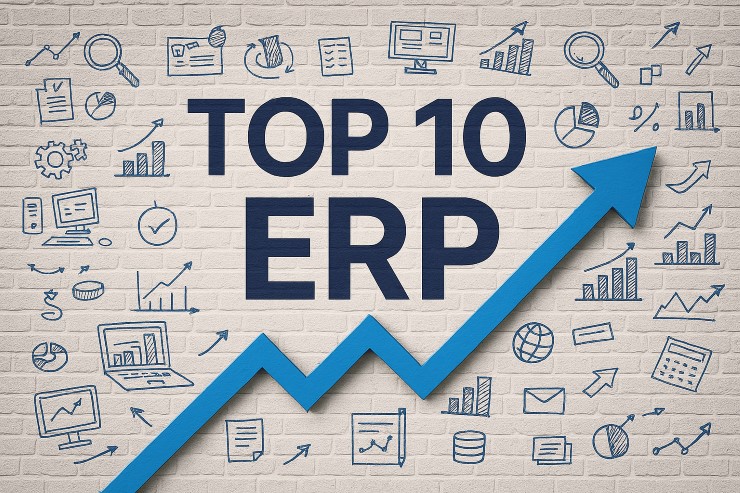
Increasingly, choosing the right ERP software is key to driving digital transformation, improving competitiveness, and ensuring scalability in a changing market environment. In this article, we present the TOP 10 ERP solutions according to Dataprix, describing their most notable features, use cases, and selection criteria. Finally, we include a comparative table summarizing key aspects of each platform.
What is an ERP and why does your company need it?
An ERP is a set of integrated modules that share data in real time, eliminating information silos and improving interdepartmental collaboration. Its main benefits include reducing operational costs, speeding up processes, improving customer experience, and the ability to scale according to business growth. Additionally, modern ERP solutions incorporate advanced analytics, customizable dashboards, and emerging technologies like AI for financial or demand forecasting, enabling proactive, data-driven management.
Thanks to its ability to automate tasks, provide real-time visibility, and facilitate data-based decision-making, ERPs have become a strategic priority for companies of all sizes.
Migrating to a cloud ERP facilitates the adoption of automatic updates, reduces on-premise infrastructure burdens, and provides flexibility to work from anywhere. However, many companies choose hybrid models or on-premise deployments when greater control over sensitive data is required or to comply with strict regulations. In any case, the decision must align with IT strategy, budget, organization size, and growth expectations.
Key criteria for selecting an ERP
-
Scalability and architecture: evaluate whether the solution supports future growth and changes in demand (multitenant vs. single-tenant, cloud, hybrid, or on-premise).
-
Modularity and integration: the ability to activate modules based on needs (finance, SCM, HR, CRM, production, etc.) without excessive complexity.
-
Emerging technologies: incorporation of AI, machine learning, and integrated analytics for automation and prediction (financial anomalies, demand forecasting, performance analysis).
-
Usability and user experience: intuitive interface, mobile/apps, ease of configuration and customization.
-
Ecosystem and partners: community of integrators, specialized consultancies, and marketplace for extensions or add-ons.
-
Security and compliance: certifications, data encryption, access control, and compliance with local/international regulations.
-
Total cost of ownership: licensing (SaaS subscription vs. perpetual license), implementation, maintenance, training, and support costs.
-
Multilingual support and localization: essential for multinational companies or those operating in different countries.
-
Implementation time: speed and complexity of deployment, availability of predefined configurations for specific sectors.
-
Mobility and remote access: web and mobile access for distributed or remote teams.
TOP 10 ERP software according to Dataprix
At Dataprix, we have selected and ranked what we consider the 10 best ERP solutions in the market.
Our ranking is based on publications and studies from leading IT software analysts like Gartner and its Magic Quadrants, Forrester Research and its Forrester Wave, user review websites like G2 and Capterra, as well as our own experience.
Below is the Dataprix ranking detailing the 10 ERP solutions deemed most relevant for 2025, with descriptions of their key features and typical use cases.
1. Oracle Fusion Cloud ERP
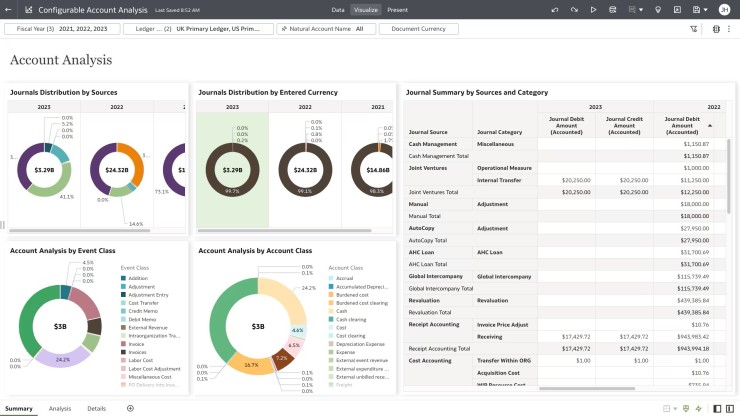
Oracle Fusion Cloud ERP is a cloud-native, multitenant solution that integrates critical financial, operational, and supply chain processes into a single centralized platform. It incorporates artificial intelligence and machine learning to automate routine tasks, anticipate transaction anomalies, and offer real-time analytics that facilitate strategic decision-making.
Its SaaS architecture reduces dependence on on-premise infrastructure and enables global scalability, with automatic updates and extensive integration capabilities with other Oracle Cloud services and third-party systems.
It is ideal for medium and large companies seeking a modern ERP with strong finance, procurement, project management, and accounting capabilities.
2. Microsoft Dynamics 365 ERP
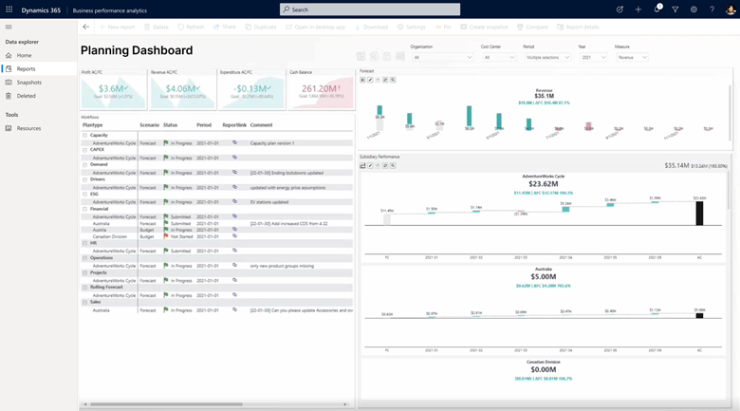
Microsoft Dynamics 365 ERP offers a modular and integrated set of cloud applications for finance, supply chain, projects, and operations, connected through Microsoft’s Common Data Service.
It integrates natively with Microsoft 365, Power Platform, and Azure, facilitating gradual adoption by organizations already operating in the Microsoft ecosystem. It includes AI and embedded analytics capabilities to optimize processes, forecast financial flows, and improve customer experience.
It is ideal for companies of various sizes, especially those requiring close collaboration with Microsoft productivity tools and seeking flexibility to add modules as needed.
3. SAP S/4HANA
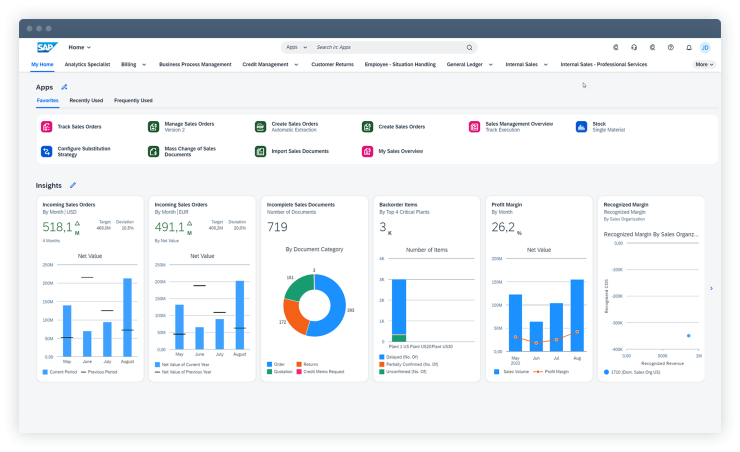
SAP S/4HANA, SAP’s new generation ERP based on the in-memory HANA platform, integrates finance, logistics, and real-time analytics into a single intelligent platform.
It offers on-premise, public or private cloud, and hybrid deployments, with regular updates enabling continuous innovation. Its strength lies in in-memory processing for fast analytics, AI-based forecasts, and a process-oriented architecture for simplification.
It is especially recommended for large enterprises and multinationals requiring high customization, robust transaction handling, and a broad ecosystem of partners and industry-specific extensions.
4. Infor CloudSuite Industrial
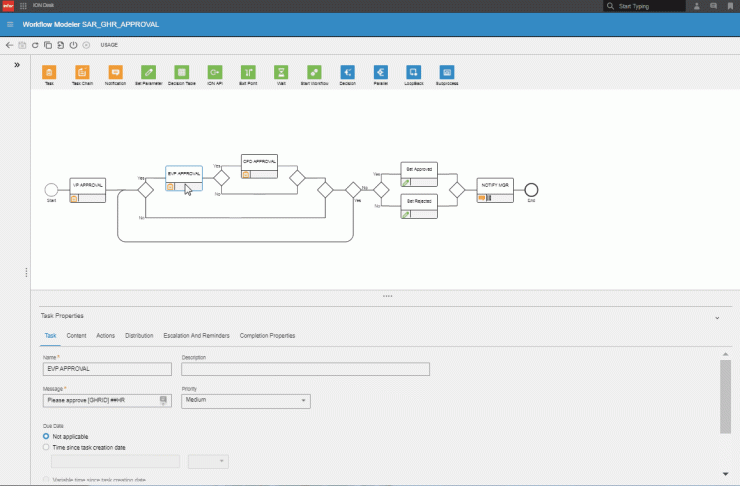
Infor CloudSuite Industrial (formerly SyteLine) is a cloud ERP focused on manufacturers (discrete and process), designed to manage end-to-end production operations.
It provides integrated modules for advanced planning and scheduling (APS), inventory management, production control, supply chain, financial accounting, quality management, and after-sales services. Its modular and industry-oriented architecture allows specific configurations without heavy custom development. It leverages the Infor OS platform and AWS infrastructure, with integrated analytics and IoT and machine learning capabilities to improve operational efficiency and real-time visibility.
It is suitable for medium and large manufacturing companies seeking a production-specialized ERP.
5. Epicor Kinetic ERP

Epicor Kinetic ERP (formerly Epicor ERP) is primarily aimed at manufacturing and distribution companies, with modules for financial management, supply chain, manufacturing, CRM, human resources, and business analytics.
It offers both on-premise and cloud (SaaS) deployment, maintaining a single code base to simplify migrations and updates without operational interruptions. Its modular architecture allows purchasing only necessary components and scaling with business growth. It includes IoT capabilities and integration with plant devices for real-time monitoring, as well as built-in analytics functions supporting manufacturing and distribution process optimization.
6. Oracle NetSuite ERP
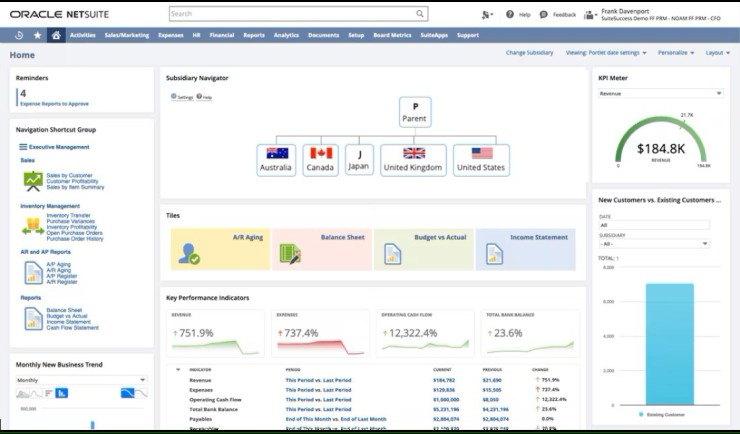
Oracle NetSuite ERP is Oracle’s native cloud ERP solution, designed to unify critical processes for medium and large organizations.
It includes modules for financial management, accounting, resource planning, inventory, sales, procurement, CRM, and human resources. Its multitenant SaaS model allows rapid implementation and global scalability, with automatic updates and a broad partner network.
NetSuite is popular among fast-growing companies or those operating in multiple markets due to its flexibility, customization capabilities via SuiteCloud, and an ecosystem of prebuilt integrations.
7. IFS Cloud

IFS Cloud is a modular ERP covering financial management, production planning, project management, asset maintenance, supply chain, human resources, and services.
It offers real-time data exchange between modules via a common platform, with IoT, embedded analytics, and AI capabilities for equipment failure prediction and maintenance optimization. It supports cloud or on-premise deployment, with hybrid options, and has a global network of partners specialized in industry implementations.
It is aimed at medium and large companies, especially in manufacturing, energy, utilities, and field services sectors.
8. Plex Manufacturing Cloud
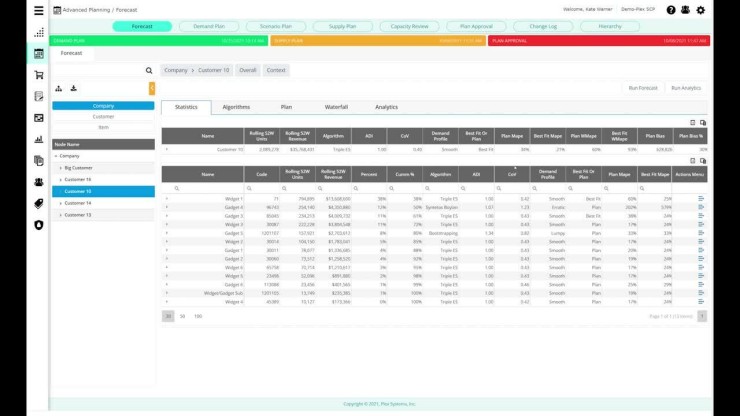
Plex Manufacturing Cloud is a cloud ERP specifically designed for managing manufacturing operations.
It includes specialized modules for production control, inventory management, quality supervision, and supply chain coordination, focusing on the manufacturing industry. It offers connectivity with plant devices for real-time tracking, integrated analytics to optimize processes, and ensure full traceability.
It is ideal for manufacturers looking for a production-oriented ERP, with rapid cloud deployment and continuous updates without interruptions.
9. Priority ERP

Priority ERP is a modular and integrated solution for enterprise resource planning, deployable in the cloud, on-premise, or hybrid configurations, adapting to infrastructure, security, and scalability requirements of SMEs and large corporations.
It covers key areas such as finance, logistics, production, sales, purchasing, CRM, and human resources, focusing on usability and quick implementation. It includes APIs and connectors to integrate third-party applications, built-in analytics, and workflow automation capabilities.
It is especially valued by companies that require deployment flexibility and controlled total cost of ownership.
10. Sage Intacct
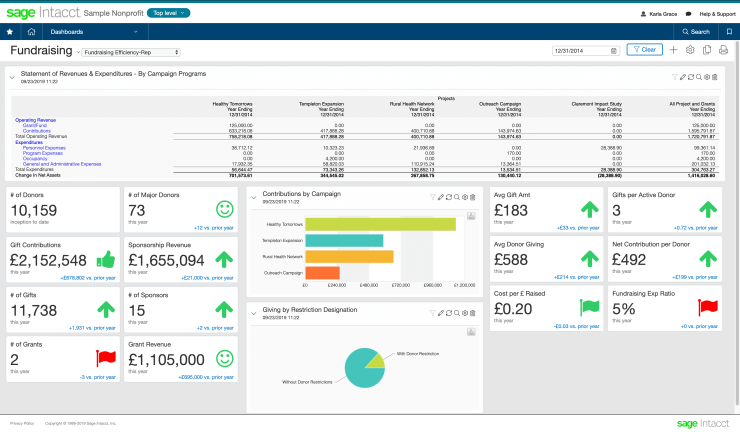
Sage Intacct is a cloud ERP platform focused on financial and accounting management, with automation of accounting processes and consolidation of critical data.
Its open architecture facilitates connectivity with other business applications through preconfigured APIs and connectors. It offers real-time financial dashboards, advanced reporting, and regulatory compliance, being widely used by companies that require financial robustness and clear visibility of key metrics. Its technological openness allows connection via APIs with other business tools such as CRMs, billing systems, and payroll solutions, providing an agile and scalable financial ecosystem for medium-sized organizations.
Comparison Table: Key Features of the TOP 10 Dataprix ERPs
| Software | Deployment | Target Audience | Main Modules | Technology/AI | Updates/Support | Key Advantages |
|---|---|---|---|---|---|---|
| Oracle Fusion Cloud ERP | Multitenant Cloud | Medium and Large Enterprises | Finance, SCM, Procurement, Projects, HR | Integrated AI/ML, real-time analytics | Automatic in the cloud | Global scalability, broad integration with Oracle Cloud |
| Microsoft Dynamics 365 ERP | Cloud (Azure) | SMEs and Large | Finance, SCM, Projects, CRM, HR | Integrated AI, Power Platform | Continuous updates | Microsoft ecosystem, modularity, Office 365 integration |
| SAP S/4HANA | Public/Private Cloud, On-premise, Hybrid | Large and Multinationals | Finance, Logistics, Production, HR, SCM | In-memory HANA, AI for forecasting | Periodic updates (quarterly in cloud) | Robustness, real-time analytics, broad ecosystem |
| Infor CloudSuite Industrial | Cloud (AWS) / Hybrid | Medium/Industrial | APS, Inventory, Production, SCM, Finance | Analytics, IoT, automation | Automatic updates | Manufacturing specialization, industry verticals |
| Epicor Kinetic ERP | Cloud and On-premise | Manufacturing and Distribution | Finance, SCM, Manufacturing, CRM, HR | IoT integration, embedded analytics | Same releases on cloud and on-prem | Same code base, ease of migration |
| Oracle NetSuite ERP | Multitenant Cloud | Medium and Large | Finance, Inventory, CRM, HR, Purchasing | Embedded analytics, customizable | Automatic in the cloud | Fast deployment, partner ecosystem |
| IFS Cloud | Cloud / On-premise / Hybrid | Medium and Large | Finance, Projects, Maintenance, SCM, HR | AI for predictive maintenance | Flexible updates | Strong in services, asset maintenance |
| Plex Manufacturing Cloud | Cloud | Manufacturing | Production, Inventory, Quality, SCM | Plant connectivity, real-time analytics | Continuous without interruptions | Exclusive focus on manufacturing, total traceability |
| Priority ERP | Cloud / On-premise / Hybrid | SMEs and Corporations | Finance, SCM, Production, CRM, HR | Workflow automation, analytics | Periodic updates | Deployment flexibility, controlled total cost of ownership |
| Sage Intacct | Cloud | Medium (financial focus) | Finance, Accounting, Reporting, HR | Real-time reporting, integrations | Automatic updates | Strong in finance, agile financial ecosystem |
Frequently Asked Questions (FAQ)
-
How long does an ERP implementation take?
It depends on complexity, company size, and number of modules. A typical cloud implementation for medium-sized companies can take between 3 and 9 months, while for large corporations or highly customized projects it may exceed one year. -
What costs should I consider?
Besides subscription or licenses, costs include consulting services, integration with existing systems, data migration, user training, and ongoing maintenance. It is key to analyze the total cost of ownership (TCO) in the medium term. -
Is cloud or on-premise ERP better?
-
Cloud (multitenant SaaS): lower initial infrastructure investment, automatic updates, scalability, and remote access.
-
On-premise: greater control over data, possible compliance with very strict regulations, but requires investment in hardware and IT staff.
-
Hybrid: combines both for cases where certain workloads or data must remain on-site.
The choice depends on IT strategy, sector regulations, and internal support capabilities.
-
-
How to leverage AI in my ERP?
Modern solutions integrate AI for predictive analysis, anomaly detection, and automation of financial or production processes. It is important to have clean data and a partner to help configure machine learning models tailored to the business. -
Which sectors benefit most from specialized ERP?
-
Manufacturing: Infor CloudSuite Industrial, Epicor Kinetic, Plex Manufacturing Cloud.
-
Services and asset maintenance: IFS Cloud.
-
Finance-intensive: Sage Intacct, Oracle Fusion (financial modules).
-
Multinationals and large companies: SAP S/4HANA, Oracle Fusion Cloud ERP, Microsoft Dynamics 365 (with global ecosystem).
-
-
How to evaluate flexibility and customization?
Check availability of APIs, extension marketplaces, ease of configuration (low-code/no-code), and existence of partners with sector experience. Platforms with modular architecture and cloud services usually offer greater flexibility without heavy development.
Conclusion and Next Steps
Choosing an ERP is a strategic decision that impacts all company processes. It is fundamental to optimize internal processes, improve decision-making, and achieve competitiveness in today's business environment. Each solution presented in this TOP 10 offers unique advantages that suit various types and sizes of companies. Explore each tool in detail in our software directory and choose the one that best fits your organization's needs, bearing in mind that it is a high-impact decision, and it is also advisable to follow these recommendations:
-
Perform an internal diagnosis: map critical processes, user needs, and business objectives.
-
Evaluate demos and pilot tests to check usability and fit with daily operations.
-
Review references and success stories from companies in the same sector or size.
-
Analyze TCO over 3‑5 years, considering licenses, implementation, support, and updates.
-
Consider organizational culture and change capacity: an ERP implies process adaptation and team training.


